Prize-winning novelist Sue Amos shares her top tips for writing historical fiction, and discusses why it’s so important to embrace the editing process.

Can you tell us about your creative process for writing your new book Teardrop? Where did the idea come from and how did you grow it into a book?
I wanted to introduce the Burghers of Sri Lanka to a wider audience as most people have no knowledge of this tiny ethnic group. I wove the strands of the plot out of a strange anecdote that my Sri Lankan father once shared when I was young and used it in the novel as the backstory to a crime. With the introduction of the main character, Jazz, a modern young Burgher woman, the novel shifted focus and became her story as she navigated a career for herself as a newspaper reporter against traditional expectations, in a changing nation.
The book is set in 1950s Ceylon, and is underpinned by the tensions of post-colonialism. How do you approach the research process? Can you share any tips you have for writing historical fiction and painting a setting so vividly?
I read widely around the subject beforehand - history books and novels, travelogues and poetry, films, music, maps. Surf the net, go to museums and art galleries. Anything that gets the story into your blood. I tend to do this for months, to give it time to brew. I don’t write during this period, other than to jot things down in a notebook. When I eventually start, I create a timeline, plotline and character bios which I add to once I begin writing.
For Teardrop, I was fortunate to have a live source in the shape of my father. I had a lot of specific questions about what he remembered from that place and time, so I ‘interviewed’ him a number of times! So facts were relatively easy and available for me to use in the assembly of the story skeleton. But writing historical fiction can be…annoying. You’re in the middle of writing an emotional scene, your character gets up to make a soothing cup of tea and you suddenly find yourself thinking, wait…what kind of tea? What style of cup? Biscuit brand? And because it’s historical, you want to put in those details to anchor it to the timeline, add some richness to the event, however small. Then it’s back to trawling the net, poring through the history books, skimming through chapters in novels… or emailing the live source. In Teardrop I had two historical eras; 1950s Ceylon and 1950s London – two very different places, so double the research!
You won the Watson, Little x Indie Novella Prize in 2023. What was the impact that winning this prize had on your writing career?
It’s validation. I had very little faith in myself as a writer and when I was first longlisted and then shortlisted, I was completely flummoxed. I had entered the competition at a point when I was very unsure about the novel, and I just needed to ‘take its temperature.’ When I actually won the competition, I was astounded. When Indie Novella said they would like to publish Teardrop, I felt as though I had crossed the border into a profession. Nowadays, I feel comfortable saying that I’m a writer.
You have self-published two titles before publishing 'Teardrop' with independent publisher Indie Novella. Can you tell us about your experience of transitioning from self-publishing to indie publishing, and anything you learnt along the way?
It’s great to be able to self-publish but I think it works better for some genres than others – hist-fic is a hard sell anyway, but I found it hard to gain visibility. When I was offered a publishing contract with Indie Novella I decided to mark the occasion by publishing under my own name rather than the pen name I had used previously – coming out of the shadows, you might say. I think if I’ve learnt anything it’s not to underestimate the process of editing – I embraced it. It made Teardrop a far better book than it would have been otherwise. Also to maintain my social media accounts and website and take them a little more seriously (but not too seriously!)
After a freelance television career, Sue Amos took a career break and began to write in her spare time. Inspired by forgotten, misremembered scraps of history, she wrote two novels under the pen name Sarah Roux. Her first, A Painted Samovar is a homage to her maternal Jewish grandfather while The Chronicles of Harriet Shelley gives voice to the first wife of the poet, Percy Shelley.
Submitting her 3rd novel to the Watson Little x Indie Novella Prize, Sue decided she needed to come out from the shadows to write under her real name, having an inkling this would prove to be auspicious! Born and bred in North London, and now resides in the Chilterns with her husband, son, and dog, Teardrop also represents a tribute to Sue’s Sri Lankan heritage and her work shedding light on the post-colonial culture of her ancestors. Teardrop won the 2023 Watson Little x Indie Novella Prize.
Comments